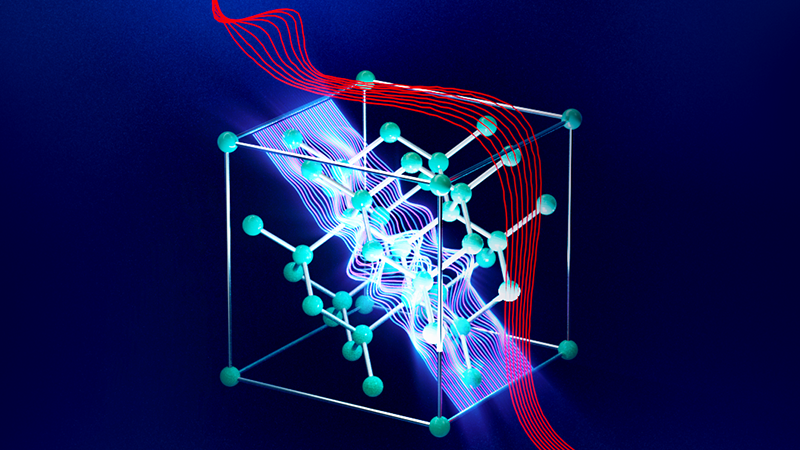Researchers at Purdue unlock light-matter interactions on sub-nanometer scales, leading to ‘picophotonics’
2022-11-14

Researchers at Purdue University have discovered new waves with picometer-scale spatial variations of electromagnetic fields which can propagate in semiconductors like silicon. The research team, led by Dr. Zubin Jacob, Elmore Associate Professor of Electrical and Computer Engineering and Department of Physics and Astronomy (courtesy) published their findings in APS Physics Review Applied in a paper titled, “Picophotonics: Anomalous Atomistic Waves in Silicon.”
“The word microscopic has its origins in the length scale of a micron which is a million times smaller than a meter. Our work is for light matter interaction within the picoscopic regime which is far smaller, where the discrete arrangement of atomic lattices changes light’s properties in surprising ways.” says Jacob.
These intriguing findings demonstrate that natural media host a variety of rich light-matter interaction phenomena at the atomistic level. The use of picophotonic waves in semiconducting materials may lead researchers to design new, functional optical devices, allowing for applications in quantum technologies.
Light-matter interaction in materials is central to several photonic devices from lasers to detectors. Over the past decade, nanophotonics, the study of how light flows on the nanometer scale in engineered structures such as photonic crystals and metamaterials have led to important advances. This existing research can be captured within the realm of classical theory of atomic matter. The current finding leading to picophotonics was made possible by a major leap forward using a quantum theory of atomistic response in matter. The team consists of Jacob as well as Dr. Sathwik Bharadwaj, research scientist at Purdue University, and Dr. Todd Van Mechelen, former post-doc at Purdue University.
The long-standing puzzle in the field was the missing link between atomic lattices, their symmetries and the role it plays on deeply picoscopic light fields. To answer this puzzle, the theory team developed a Maxwell Hamiltonian framework of matter combined with a quantum theory of light induced response in materials.
“This is a pivotal shift from the classical treatment of light flow applied in nanophotonics” says Jacob. “The quantum nature of light’s behavior in materials is the key for the emergence of picophotonics phenomena.”
Bharadwaj and colleagues showed that hidden amidst traditional well-known electromagnetic waves, new anomalous waves emerge in the atomic lattice. These light waves are highly oscillatory even within one fundamental building block of the silicon crystal (sub-nanometer length scale).
“Natural materials itself have rich intrinsic crystal lattice symmetries and light is strongly influenced by these symmetries” says Bharadwaj. “The immediate next goal is to apply our theory to the plethora of quantum and topological materials and also verify the existence of these new waves experimentally.”
“Our group has been leading the frontier of research on pico-scale electrodynamic fields inside matter at the atomistic level,” says Jacob. “We recently initiated the picoelectrodynamics theory network where we are bringing together diverse researchers to explore macroscopic phenomena stemming from microscopic pico-electrodynamic fields inside matter.”
This research was funded by the DARPA QUEST program.
About the Department of Physics and Astronomy at Purdue University
Purdue Department of Physics and Astronomy has a rich and long history dating back to 1904. Our faculty and students are exploring nature at all length scales, from the subatomic to the macroscopic and everything in between. With an excellent and diverse community of faculty, postdocs, and students who are pushing new scientific frontiers, we offer a dynamic learning environment, an inclusive research community, and an engaging network of scholars.
Physics and Astronomy is one of the seven departments within the Purdue University College of Science. World-class research is performed in astrophysics, atomic and molecular optics, accelerator mass spectrometry, biophysics, condensed matter physics, quantum information science, particle and nuclear physics. Our state-of-the-art facilities are in the Physics Building, but our researchers also engage in interdisciplinary work at Discovery Park District at Purdue, particularly the Birck Nanotechnology Center and the Bindley Bioscience Center. We also participate in global research including at the Large Hadron Collider at CERN, Argonne National Laboratory, Brookhaven National Laboratory, Fermilab, the Stanford Linear Accelerator, the James Webb Space Telescope, and several observatories around the world.
About Purdue University
Purdue University is a top public research institution developing practical solutions to today’s toughest challenges. Ranked in each of the last five years as one of the 10 Most Innovative universities in the United States by U.S. News & World Report, Purdue delivers world-changing research and out-of-this-world discovery. Committed to hands-on and online, real-world learning, Purdue offers a transformative education to all. Committed to affordability and accessibility, Purdue has frozen tuition and most fees at 2012-13 levels, enabling more students than ever to graduate debt-free. See how Purdue never stops in the persistent pursuit of the next giant leap at https://stories.purdue.edu.
Contributors:
Writer: Cheryl Pierce, Communications Specialist
Graphic provided by Dr. Zubin Jacob, Elmore Associate Professor of Electrical and Computer Engineering and Department of Physics and Astronomy (courtesy)
Reference:
[1] Sathwik Bharadwaj, Todd Van Mechelen, and Zubin Jacob, Picophotonics: Anomalous Atomistic Waves in Silicon, Physical Review Applied 18, 044065 (2022). https://link.aps.org/doi/10.1103/PhysRevApplied.18.044065